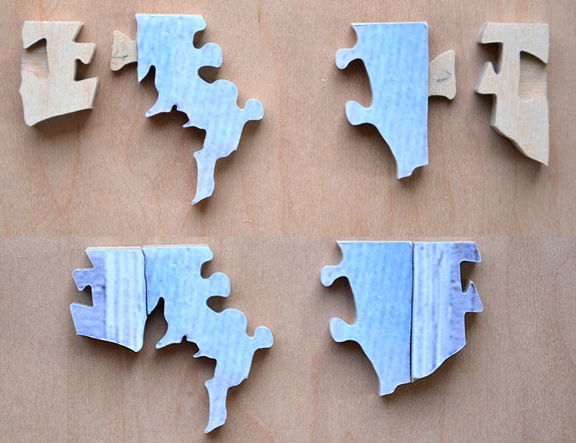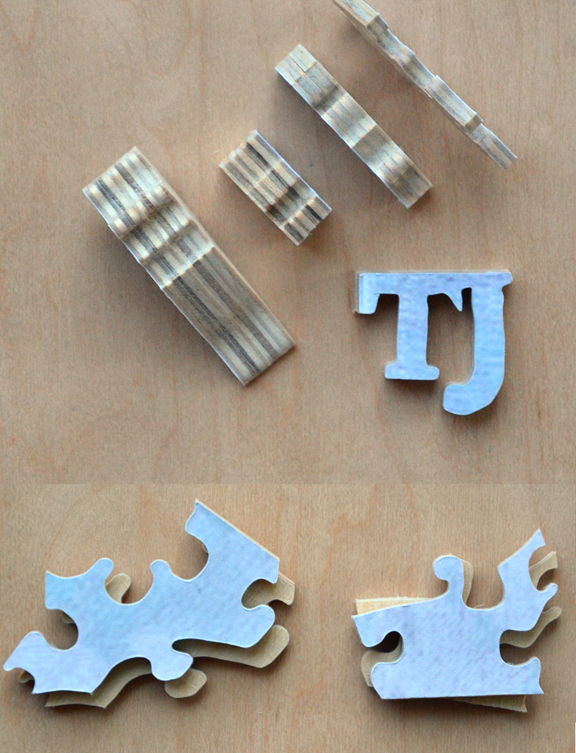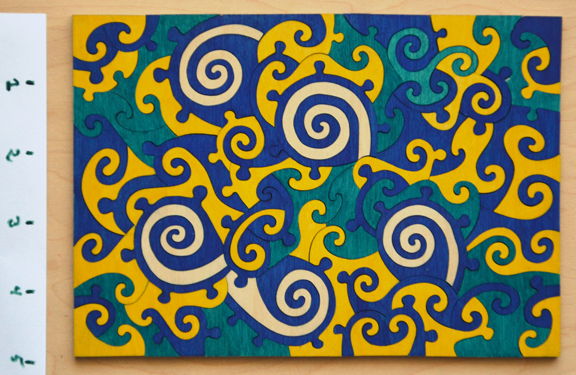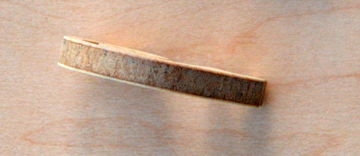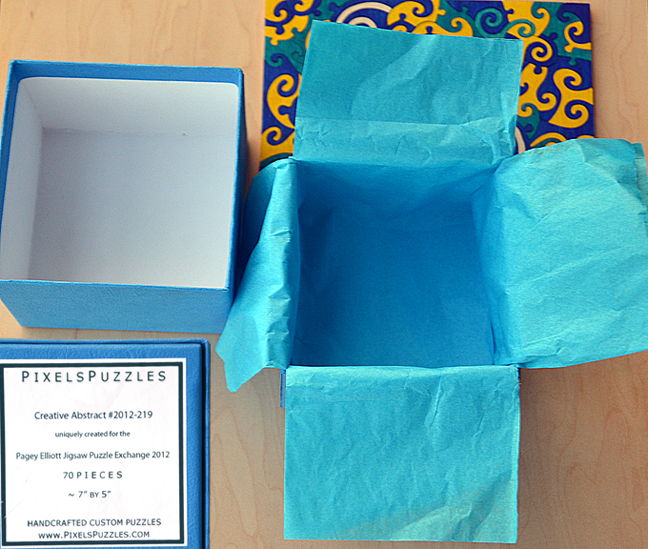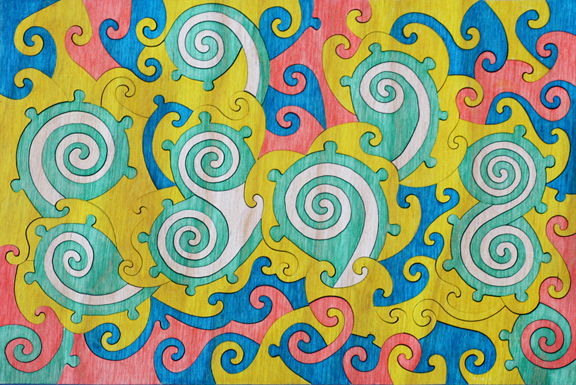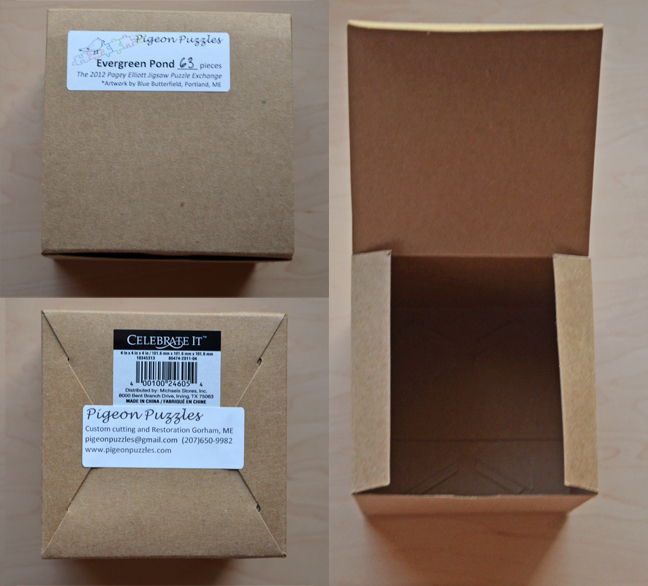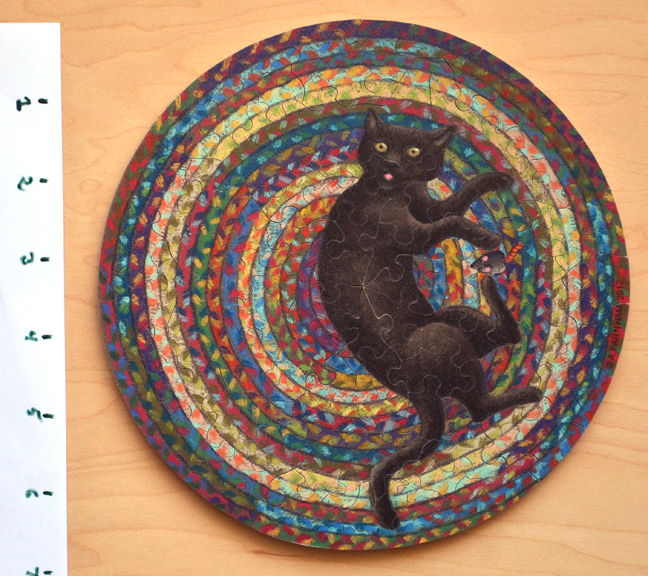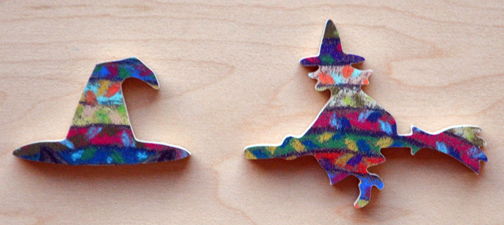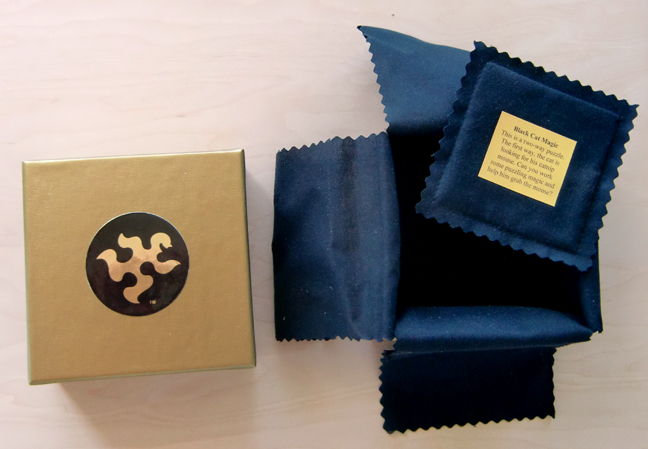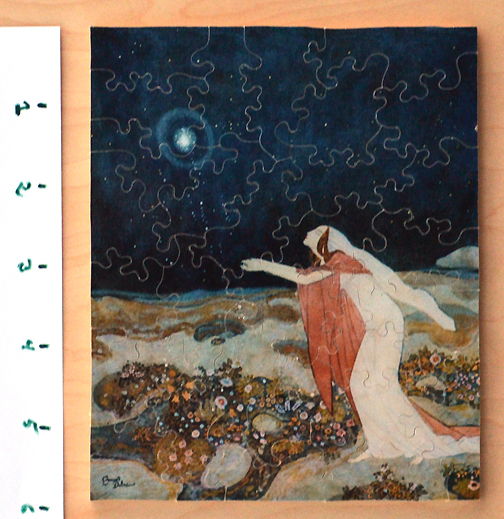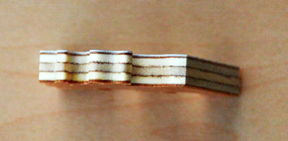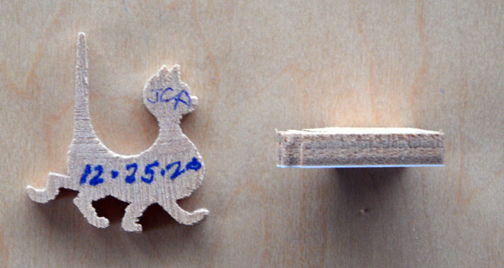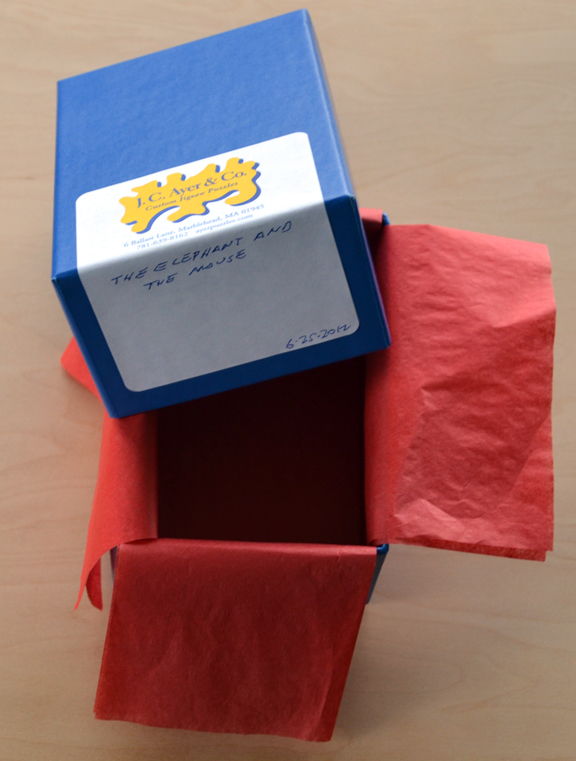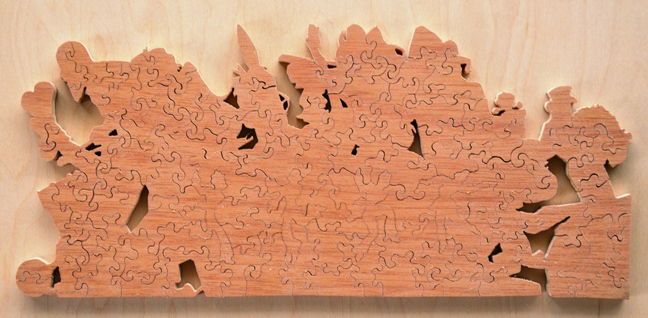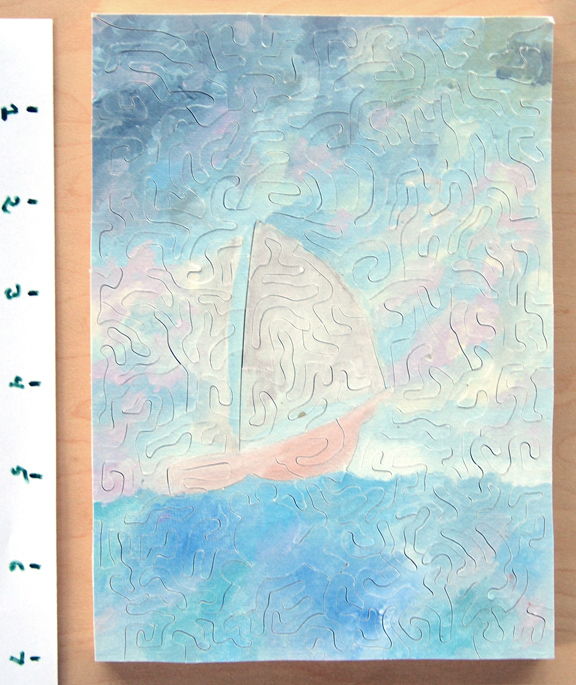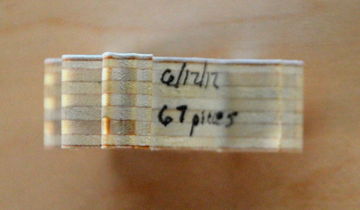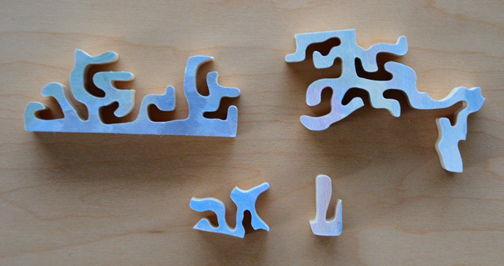Review #1 - September 6, 2012
Puzzle Cutter: David Beffa-Negrini
Company: Fool's Gold
City: Harrisville NH
Website: www.foolsgoldpuzzles.com

Bountiful Butterflies - Front

Bountiful Butterflies - Back
Cutting style - Earlet with some "split knobs"
and a little clc
Yes I got the ruler backwards here, too late, the puzzle is now apart!

Signature piece (two piece "Jester"), two figurals of children with butterfly nets, and a piece shown edge-on

Box

Inviting Pile
69 pieces
David has been offering puzzles via Fool's Gold since 1997, making him one of the veteran puzzle cutters of the group. This puzzle is unusual as there are pictures on both sides. The picture on the back side is the same as the picture on the front side, but reversed and precisely aligned with the front side picture so the same portion of the picture is on both sides of the each piece! One of the pieces in the puzzle is a color line cut butterfly and the edges of the piece are aligned extremely well with the picture on both sides. Not something that I've ever done. Having the same pictures on both sides made the puzzle a lot more challenging. David has double sided cutting down to a science, there is no tear-out evident on either side, quite nice. The paper is a variety of Epson Matte paper, a kind I've used in the past - gives the pieces a fairly soft feel. I've had problems with sharp corners doing intra-layer delaminating or having little white points, however the cutting style used for this puzzle works well with the paper.
The puzzle comes in a very nice box with a black and gold pouch with drawstring and a write-up about his company included. Hmmmmm..... a write up ..... something I should do?
The wood is super unusual as it a single ply (bass-wood). Normally, David's puzzles are one sided and according to his write-up, the bass wood is backed with a "double-thick" mahogany veneer that he bonds himself (!) and then oils when done.
A few quibbles: I like to see a piece count on the box. None-here, in fact a surprising number of Exchange cutters did not, so yeah maybe it's just me! David wrote in response "When a person orders a puzzle, I include the piece count on their order form as well as what's crafted in for figurals. I like the labels to have a clean look so I do not include anything more than the title on the label. My original labels had the title, piece count, initials who cut it (me), initials who inspected it (my wife), fool time (guesstimated time to put it together), address, and probably more I've forgotten!"
One other thing, on the signature piece, is the cutter's initials and "7/12". I like to see four digit years, e.g. 7/2012 as I'm thinking for future generations the year could be lost for those way-in-the-future collectors. But David does get off the hook here as "2012 Pagey Elliott Jigsaw Puzzle Exchange" is written on the box!
So there you have it, the first of 20 puzzles. Many more cool puzzles to come!
One big coincidence: I went to a boarding high school (which no longer exists) in Harrisville, NH, the tiniest of towns, and here is David's company with a Harrisville, NH address! Small world.
Review #2 - September 7, 2012
Puzzle Cutter: Melinda Shebell
Company: Jardin Puzzles
City: Stowe, MA
Website: www.jardinpuzzles.com

Pagey Elliott Puzzle Exchange - Front
This is the layered solution, the upper right and lower left text sections are stacked on top of other pieces via peg connectors
Hard to tell in this photo - look at the shadows

Pagey Elliott Puzzle Exchange - Back
First layer only, with peg connectors removed

Two of the four peg connectors

The four text sections assembled as a separate puzzle
The four sections can also go together in a single row of four
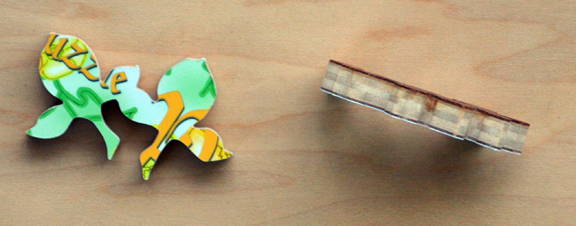
Signature Piece and piece shown edge-on

Box with some guidance
Not shown - some nice blue tissue paper that came inside the box

Inviting Pile
101 plus four peg pieces. Label said "About 100"
Melinda is another veteran puzzle cutter, she cut her first puzzle in October 1999 and has cut well more the 600 since then to critical acclaim. This puzzle is unusual in that it can be assembled several ways. Included are four little pieces with pegs which can be placed within spaces in a first layer solution to take on pieces for a second layer. There are four regular pieces which have a little hole drilled in their back for placement on the pegs.
I found the puzzle surprisingly difficult even just to assemble the sections - eventually I realized that each of the sections have green edges, this helped quite a bit. The "leaf knob" cutting style is tricky, and is not one I've ever cut. I eventually solved the two layered puzzle and variants of the text sections. I did not solve the "One Puzzle" solution where everything fits together as single layer, with the "peg" pieces not required. Some day I may work on it again. While I consider myself an accomplished puzzler, for some reason or other, puzzles with multiple solutions frequently stump me! Hidden in this puzzle are some double cuts, which may or may not be causing the "problem".
The wood is a 5-ply with mahogany on both exterior sides and maple or poplar in the interior. There is quite a variation in the appearance of the back-side pieces and in looking at the photo of the back side, it is obvious one should not look at the grain for confirmation of how the sections go together! Melinda has done other trick puzzles, a notable one being her "Wreath" puzzle.
The signature piece is signed "Melinda 7/21/12" "PEPE LE8", with PEPE standing for Pagey Elliott Puzzle Exchange and "LE8" standing for "Limited Edition #8". This puzzle was made exclusively for the Puzzle Parley, no additional puzzles will be offered for sale outside the Parley.
On thing I not going to do is to repeat quibbles like using the full year for date documentation. Any quibble mentioned so far in these reviews won't be repeated going forward, unless particularly necessary. Only thing here is that the pegs were angled and a bit of a challenge to fit in correctly with the "female" pieces, I'd probably make them close to true vertical and the holes not quite so tight. However, as a "demonstrator puzzle" as Melinda puts it, the puzzle more than achieved her goal of showing what is possible. And, I must report this: her puzzle won the "Best of Show" award for the Exchange Puzzles at the Puzzle Parley!!!
Melinda made a major effort for this Puzzle Parley Puzzle Exchange puzzle, this puzzle must have taken quite a while to design, both the artwork and the tricks, and of course the cutting.
So there you have it, the second of 20 puzzles. And still, many more cool puzzles to come!
Review #3 - September 8, 2012
Company Representative: Chris Wirth
Company: Liberty Puzzles
City: Boulder, CO
Website: www.libertypuzzles.com

Pileated Woodpecker - Front
I forgot to include my ruler with the photos. This puzzle is about 15" high.
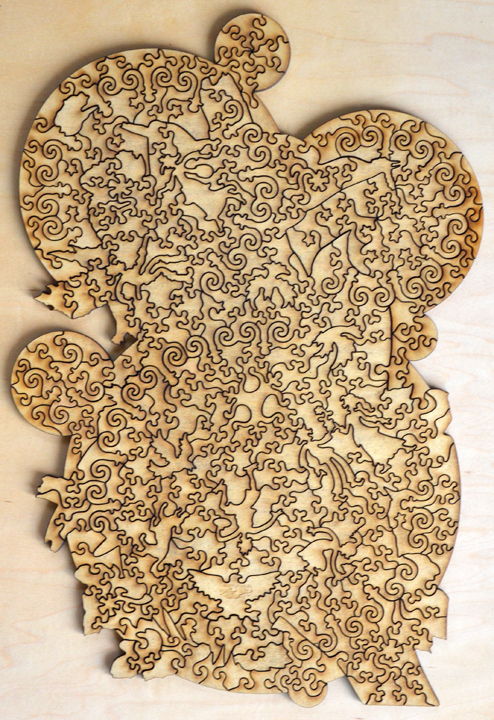
Pileated Woodpecker - Back

Figurals
(Signature Piece included here, bottom)

Piece shown edge-on and Signature Piece

Box

Pile of pieces. Inviting?
275 pieces
Liberty Puzzle cuts their puzzles with a laser, so there is no "puzzle cutter" rather there are puzzle "designers". Liberty Puzzles has 20 employees and sold their first puzzle in 2005. I do not have all my facts here. Chris Wirth, who was at the Puzzle Parley, is certainly one of the main movers at the company, and I think the founder. I'll update this as I get more information. Chris kindly answered my questionnaire, I think it best to use his words here about this puzzle: This was a John Audubon woodpecker print which Anne Williams astutely noticed we digitally color enhanced. Then we added the background blue color/shapes to fit where the cut pattern was going to lay out. So the design of the puzzle print was closely correlated with the intended cut pattern. After that the cut design is laid out and drawn by hand on the computer. All of this work is done by our designer Lynon Aksamit. I asked him to do a special concept & design specifically for this Exchange puzzle. I knew we were trading with some of the best, so we had to come up big. Lynon has become a beautiful designer of cut patterns and puzzling tricks, but he's also gotten really good at digital graphics and puzzle concepts. He's a fine painter as well, so he's evolved into an artist with a tremendous number of skills.
Long before Liberty Puzzles was founded, Wentworth Puzzles came out with laser cut puzzles. I bought one on eBay in June of 2000 to see what they were about. Back then the technology was in early development, the puzzle was very sooty and had scorch marks that came through to the front, also the puzzle was not imaginatively cut at all.
I found this puzzle to be expertly designed and despite some continued misgivings about the scorched scent and a little soot on my hands, the puzzle was a pleasure to put together. Chris described how color line cutting is achieved - as the laser cannot follow color lines nor is registration of the print with the laser cutting machine easy at the tolerances required for good color line cutting, rather two separate boards are cut . One with, say, the inside print with some excess printing extending to the outside, and the other one with, say, the outside print with some excess printing extending to the inside - the excess areas are discarded and the two cut sections appear to be perfectly color line cut even though there was absolutely no color line cutting at all! The figurals remind me of PAR Puzzle figurals. Chris, at the Parley discussed his family's connection with Falls Puzzles. Falls puzzles also had similar "people" figurals. Chris' company has studied the things which makes a puzzle popular. I found the irregular border to be tricky and was delighted to find there was yet another "blue bubble" in the way to be solved. Also there were a couple areas of "green leaves" which didn't go anywhere with the central image, rather they were "color line cut" islands within the blue spaces, this was neat. The cutting line style consisted of a mixture of Earlet, knob, and with some areas of "star knobs", "pawn head knobs" and curls. The front was crisp and clean.
The signature piece has a very finely etched eagle on the back under the company name, not sure how it was done.
The puzzle comes in a nice box with green tissue. The year the puzzle was made is on the box and the label said that the puzzle is a limited edition.
The wood is a 3-ply. I didn't ask about the kind, I can assume it has been researched to see what works with lasers. The front has some kind of laminated surface.
My main quibble is that laser cut puzzles still have the "burnt wood" problem. However, the overall quality and concept of this puzzle succeeds in making this puzzle fun to assemble.
So there you have it, the third of 20 puzzles. Still many more cool puzzles to come!
Review #4 - September 9, 2012
Puzzle Cutter: Dee Rogers
Company: Platinum Puzzles
City: Canaan, NH
Website: www.platinumpuzzles.com
Sorry to say, but I'm an "epic fail" here. Try as I might, and I put in a lot of hours, I was not able to solve this puzzle, the only one of the full set of puzzles I failed at (excluding the "single puzzle" solution to Melinda's puzzle - although I did not spend much time attempting that solution variation). I'll show you what I can. If anyone (besides Dee) has solved this puzzle, send a picture of the solution and share how you went about solving the puzzle!
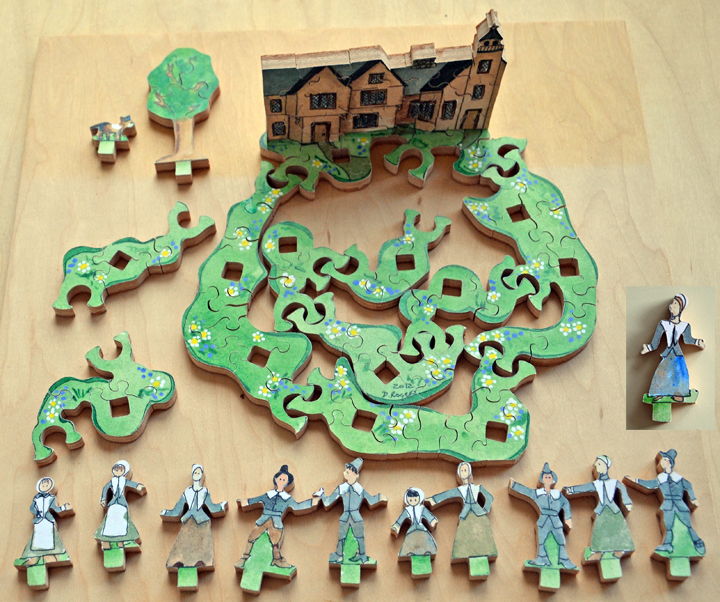
The Summer of 92 - Front
Not solved

The Summer of 92 - Back
Back of the structures with a person hiding behind the structures.

Signature Piece (front and back) and some pieces shown edge-on

Box
Twine (was around the box) with tree twig in glass vial previously secured, blue tissue and lid (left), back side of box, right

Pile of pieces
93 pieces (box label said 92)
Dee Rogers is one of the foremost trick puzzle designers and cutters in the world today, and so far she has me stumped! Dee started working for Stave Puzzles (famous for their trick puzzles) in 1997 and gained very extensive experience there, eventually as a designer, designing over 100 puzzles there for sale. In 2006 she started her own company Platinum Puzzles. Dee's family and others are also involved with Platinum Puzzles one way or another. Platinum Puzzles has grown to be quite an enterprise, there are other artists and cutters now. At the Puzzle Parley, Dee was presented with a special award, quoting from Bob Armstrong "called the 'Innovation Award' for her many ground breaking techniques shared over the last three parleys including: special pop-up pieces with shadows, complex 3d puzzles built from rearranging special pieces from a 2d puzzle, scented pieces from her Oz Limited Edition and more."
The Puzzle Parley was held in Salem, MA., a town famous for the "Salem Witch Trials" in 1692. This puzzle commemorates those scary times.
This puzzle came with no instructions or background information and I questioned Dee about this, she wrote:
My biggest regret with this puzzle was that I did not include instructions.(What was I thinking? Oh, I remember, I wasn't thinking, I was hurrying to get it done.) such a poor excuse, nothing good comes from hurrying!
This type of puzzle is called (Crazy Claw, if I was still working at Stave, but they told me to stop using their names, so we call it a Dee-spicible puzzle) - A trick that can go together more than one way, but only one way is correct.
The Summer of 92 has four border sections, these are a little larger than the rest of the sections. The rest of the grass sections fit inside this border. You need to figure on which side of the "claw" do the sections connect. You may think that there is such little difference (1/2" at most) that is does not matter, but every connection must be in the correct position for it to go together. All claw sections have claws on each end and all claws will connect to another section (no empty claws). When you have completed putting all the sections together, it forms a 6-7" circle-ish town and now you can add the pop ups, The meeting house and church, the hanging tree, and the 13 figures (cause one is a dog) that make up the village. Half are pointing fingers accusing others to be witches and the other half being accused. Abigail Williams (the little girl who started the witch scare) is hiding behind the church.
So when all is together you will have the Summer of 92 in Salem Village.
This is an original design, that I thought of, drew, painted, copied to make in to 22 puzzles, I do not intend to sell this puzzle through Platinum Puzzles so everyone who got one has a great collectable. This is not a stack cut puzzle, but still takes the title as a trick. This puzzle was designed in a way that you could not turn it over and follow the grain of the wood to put it together. Each section was cut from a different angle on the wood.
The stick in the little vial was ("something that happened to me in Salem that I wanted everyone to share it too.) About 20-25 years ago when my three children were young I loaded them into the truck and took them to Salem (back when Salem was a village and not the suburbs of Boston) just a few days before Halloween. After they had had their fill of haunted houses and watching all the scarries on the street, it was time to go home. I was looking for a souvenir and I pop into a small shop where I found a vial with a cork and a small branch inside and a little note that read "From the Hanging Tree" I was tickled at such a gruesome little find, and it was only $5.00 Later that night as we all talked to (dad, Steve) (cause he had to go to work that day) about our adventure in Salem, I was excited to show him my little gift shop find. He looked at me and smiled and gently said "ummm, honey you know any tree from the witch time would have been 300 years old?!?!"" That tree would have been long gone by now." ( burst bubble!!) So I wanted everyone to leave Salem with a bit of the hanging tree, just as I did that many years ago!!!!!
The wood is Okoume Mahogany.
The little stick in the glass vial is not going last long! Water vapor has formed inside the vial and a white fungus/mold now covers the top of the stick.
No quibbles here, just that the puzzle is so hard for me to solve! So in some way this review is about me. Why do I have such a difficult time with "Claw" puzzles? Hmmmmmm?
Minor note: The piece count was one off, 93 instead of 92, I counted 3x!
So there you have it, the fourth of 20 puzzles. Still many more cool puzzles to come!
Review #5 - September 10, 2012
Company Contact: Jesse Louis-Rosenberg
Company: Nervous System
City: Somerville, MA
Website: www.n-e-r-v-o-u-s.com

Radial Series with art by Jonathan McCabe - Front
Puzzle is about 7 1/2" in diameter

Radial Series with art by Jonathan McCabe - Back

Figurals - Right hand piece is the company signature piece for this puzzle

Signature Pieces - Company "nervous system", and Artist "Jonathan McCabe"

Box
Picture on the box is the one used for the puzzle
Figural set on the card is representative, not exact.

Pile of Pieces
79 pieces
Nervous System cuts their puzzles with a laser, so there is no "puzzle cutter" rather there are puzzle "designers". The cutting pattern for the puzzles in this series was created with computer software. "Custom software simulates crystal growth to create an organic interlocking pattern" and that the "crystal growth" is based on the "simulation of dendritic solidification". The art was created by Jonathan McCabe by "combining multiple scales of reaction diffusion with fluid flow to create a kaleidoscopic landscape of colors and patterns". The figurals also reflect biological / crystal like growth / plus science as represented by the microscope figural. So this puzzle is a tour de force of science / biology / math and other natural processes. Not clear how the figural designs are placed / merged with the computer generated cutting lines, this question was not answered. However from Nervous System's website, this process appears to be cleverly automated. For how the "Generative Jigsaw Puzzles" were created, see a really detailed description at http://n-e-r-v-o-u-s.com/projects/puzzles/#how.
I find the company to be fascinating, particularly their non-puzzle 3-D items. There are some cutting edge things going on at the company! As for the puzzle, it seems a little forced to me, puzzles with color line cutting or with some appearance of interaction between the cutting and the picture give the puzzle an integrated sense, here I see two very different things (the cutting style) and the art, as both are "busy". In my own work, in my Creative style (which is a very busy style), I prefer to place that kind of cutting on expanses of similar color, not busy on busy. As for this puzzle, I feel a bit in more in tune with their pushing the boundary of cutting styles, less so with the art.
As this is a laser cut puzzle it comes with a strong scorched wood scent.
The company's cool logo is etched on the back of one of the organic figural pieces, not clear if this piece shape appears in all puzzles as a fixed shape signature piece. A second piece has the artist's name on it.
The puzzle comes in a nice custom made wood box, the pieces were in a thin transparent plastic bag. A quibble is that the picture is prominently displayed on the box, I prefer no picture. So I didn't assemble the puzzle right away after I took it out of the box, rather I let my mind "forget" about the picture before I started assembling it. The box says "about 80 pieces", there are 79.
The wood is a 3-ply and is Birch (according to the label on the box), looks very similar to the wood used by Liberty Puzzles (see Review #3). I forgot to take an edge-on view of a piece.
So there you have it, the fifth of 20 puzzles. Still many more cool puzzles to come! So far I have reviewed just 5 puzzles, and look at the diversity!
Review #6 - September 11, 2012
Cutter: John S. Stokes III
Company: Custom Puzzle Craft
City: San Diego, CA
Website: www.custompuzzlecraft.com

Creative Showcase #1.22 - Front

Creative Showcase #1.22 - Back

Company, Puzzle #, Date, Signature
All on the outer edges
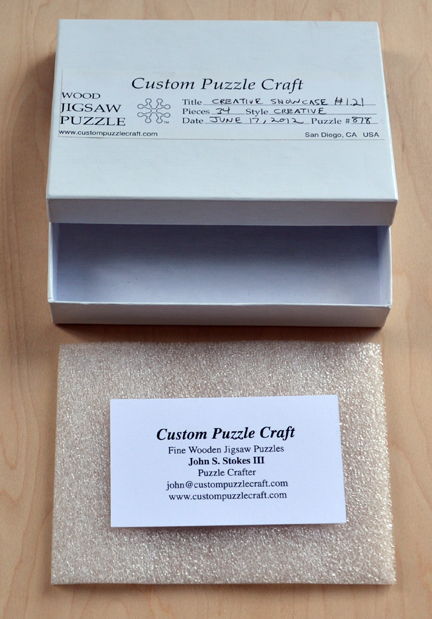
Box

Pile of Pieces
34 pieces
My puzzle is #6 on Anne Williams' Puzzle Exchange sheet and as promised I'll attempt to review my puzzle objectively and fairly! But of course interjecting my own enthusiasm. As all of the puzzles I made specifically for the Exchange were in fact exchanged, the puzzle here is one of two extras that I made for myself. I'm confident that the puzzle being reviewed here is a fair representation of the puzzles I made for the Exchange. There were four others, three of which were sold at the Puzzle Parley for $350 each and one which was given as a gift.
My puzzle was the smallest puzzle of the exchange and had the second lowest piece count of the ones I received. What I strived to do here and feel that I succeeded quite well was to "showcase" my Creative cutting style. I have three primary cutting styles (see Cutting Styles): Long Round, Swirl Curl and Creative as well as a bunch of less frequently used styles. Long Round has a simple vocabulary of rules and is great for dense cuts and is in my opinion the most difficult to assemble. Swirl Curl flows more and has a wider vocabulary of moves and is a bit easier to assemble than Long Round. Creative is an extension of Swirl Curl with a mixture of Swirl Curl and exuberant expressions of joy! In this puzzle I picked 11 elements of joy, if you will, I've been calling them "elements" recently and packed them into a 5x5 puzzle. All of the showcase puzzles had these 11 elements and they were all painted with the same colors. The arrangements were free form as I cut them dynamically without templates, each puzzle gave me its own problems to solve while cutting, each a different solution.
I used a 5-ply Apple Ply plywood, cutting the 5" x 5" squares with a table saw, sanding with 320 grit sandpaper, cutting them into 30-34 pieces, sanding and vacuuming several times, then meticulously removing whiskers (they get amplified when painted), then painting the pieces using spray paint - first one side and the edges, waiting for them to dry, then the back side. I average about one puzzle a day, although I made the puzzles in batches.
From a puzzling point of view, the puzzle does not succeed as a difficult challenge to assemble, I can assemble these in a manner of minutes! But this was not the point - the point was to cut some really cool shapes, yes to showcase my Creative style for the many people who wanted one of my puzzles in this style, and figure out what colors to paint them so the completed puzzle also looked cool! Some of the pieces I tried to make look like jewels, particularly the gold piece with the "bubble run" of five bubbles. One complaint about my Creative style is due to extreme nature of the style some pieces are quite fragile. I actually have backed off a little, but here I pretty much went all out. Also, my Creative style stresses out most papers, so this is one of the reasons I chose to go the painted piece route. I was quite happy with the way the wood cut, there were virtually no chip-outs on the back for any of the puzzles made.
The painting process was not a slam dunk. Even within the same brand of spray paint, some colors dried quickly and some took "forever". Some painted pieces form little bubbles and had to be redone, others I just left go - there is a dark green color in the puzzle which is like that.
I really liked how the pieces ended up feeling after they were painted, some are real smooth and they hardly even seem like wood!
As for the box, I feel I came up a bit short here. As it is so shallow, the lid does not fit very snuggly at all and I had to put rubber bands around them when bringing them to the Parley so they would not come open while moving them around. I kept the boxes secure with a rubber band for the exchange, but obviously that was not a good long term solution. Several cutters provided string or ribbon to tie around their boxes. I think if I had a lot more time I would have found a box with a little smaller area and deeper sides. As it was I'm happy that I found anything at all. I have a rule that the puzzle should fill at least 1/2 of the container the pieces are placed in. I've seen some puzzles come in big boxes and the pieces barely cover the bottom! For this puzzle I had to carefully arrange the pieces in three layers. If they were just jumbled in the box, the lid might not have closed in all cases. For the label, I used my standard Custom Puzzle Craft label, but had to trim about 1/8" off each end to fit the box!
I cut the puzzles with an 18" variable speed Hegner, cutting at around 1225 RPM with the .007" skip tooth "puzzle blades" available from Ben's Scroll Saw.
I am happy to say that my Exchange puzzle won the "Cutter's Choice" award at the Puzzle Parley, winning by one vote, with the votes scattered over many of the puzzles.
So there you have it, the sixth of 21 puzzles. I've been saying 20, but there are 20 others puzzle makers. Including me there are 21! Still many more cool puzzles to come!
Review #7 - September 12, 2012
Cutter: L. Keith Graves
Company: Graves Puzzles
City: St. Charles, MO
Website: www.gravespuzzles.com
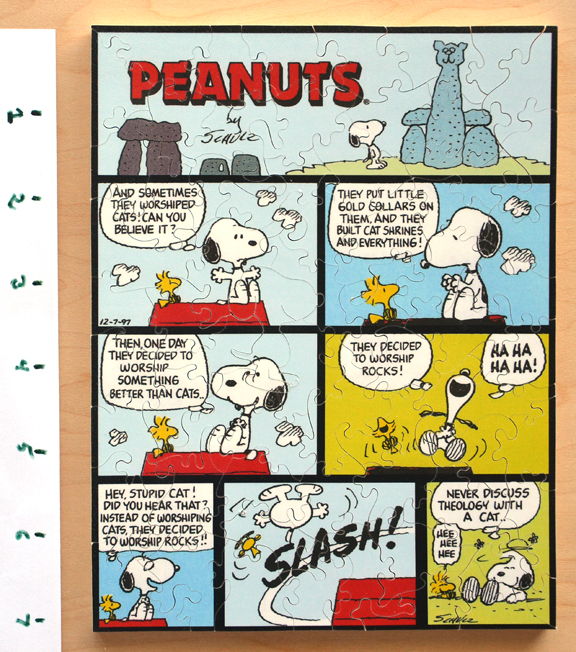
Peanuts Comic Strip - Front
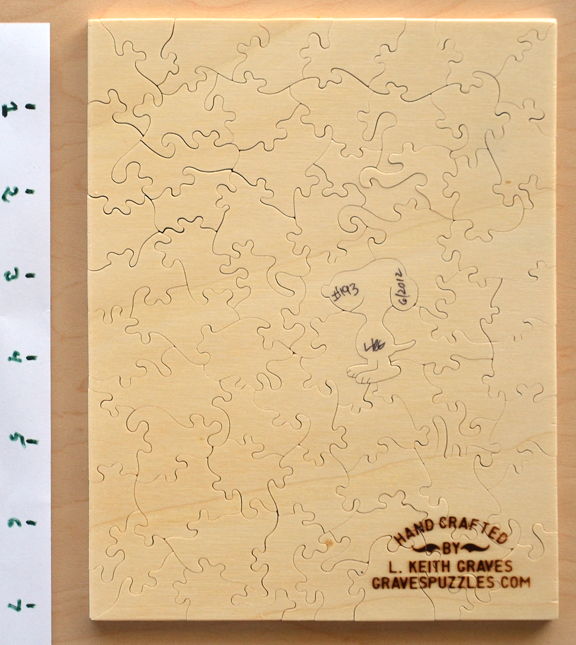
Peanuts Comic Strip - Back
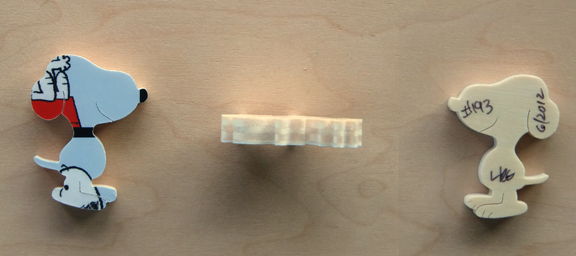
Snoopy figural (front), piece shown edge-on, same figural (back) with puzzle #, month and year, and cutter's initials

Box, with label enlarged

Pile of Pieces
65 pieces
Keith has been around as a cutter, probably for at least a few years, having cut over 200 puzzles. This puzzle is quite basic, cut in Earlet style and straight forward to assemble. There is one figural, Snoopy, with some interior highlight cuts. Keith, like at least one other cutter, placed the template for the figural in a location on the picture to complement the figural, using some of the black color between the frames for Snoopy's nose and collar.
Keith wrote about the wood: I ran out of my "good" plywood. I normally use custom made plywood that is 4 layers of high quality poplar with a mahogany back ply. I ran out for the Parley and had to use some Poplar that I had on hand. The Poplar cut fine, but I think it is too lightweight (cheap feeling) and doesn't look as nice after applying finish to the back. The bigger problem was that I ran out of Poplar and had to buy some Baltic Birch locally. It had a nice look, but the back ply was prone to chipping. I have made over 200 puzzles and have heard of people getting chip outs, but I never experienced it until this batch of Baltic Birch. So, I threw it all out, but had to make about 6 puzzles for the Exchange with it.... The woods used for my puzzles for the exchange were not up to my standards. I don't know if the puzzle I have is a Poplar wood version or Baltic Birch wood version, I suspect Poplar. I agree the back is not as nice as some of the others I've reviewed, but it is still quite acceptable. The quality of the front is excellent - a computer print on thin paper, laminated with a thin film.
As for issue of copyright, this journal is a historical document, documenting the puzzles which were exchanged at the 2012 Puzzle Parley. Quite a few of the puzzles are non-commercial "demonstrator puzzles" which were privately exchanged with other cutters at the Puzzle Parley and were not offered for sale. Keith wrote: I was very much concerned about copyright issues. But felt that since these were not for sale that I would be OK. Since they were just for demonstration purposes I hope that I am not violating any copyright laws. I try to stay very conservative with respect to this issue. If the owner of the copyright objects to me about to the pictures shown here, I'll gladly delete them. As a footnote, there was one OTHER puzzle in the exchange which had three Snoopy figurals, these will be revealed in due time.
The puzzle label said 65 pieces and that is how many there are. Two of the puzzles I received in the exchange have counts on the labels which are one off! I can see why some cutters say "about" or "more than" on their labels. I prefer to put the exact count on the label and hope I do not make a mistake counting. My process is to count in groups, usually groups of 25, and during the inspection process re-check the 25 count for each group that I inspect. The thing I like about exact counts is that in the future when the puzzle shows up on eBay, for example, the seller can count the pieces and check the total against the label and then offer an opinion as to whether or not the puzzle is complete without assembling it. Ideally the seller will assemble it! One puzzle I received in the exchange has a label which says "approximately 60 pieces" and when I counted there were 51, yet the puzzle is complete. Is this acceptable?
So there you have it, the seventh of 21 puzzles! Still many more cool puzzles to come!
Review #8 - September 13, 2012
Cutter: Ron Moore
Company: Turtle Teasers
City: Dallas, TX
Website: www.turtleteasers.com

Japanese Blue Chrysanthemums - Front
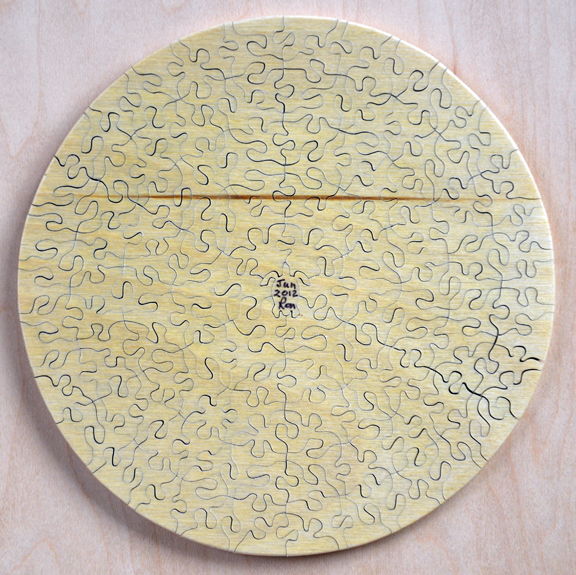
Japanese Blue Chrysanthemums - Back

Puzzle piece on-edge, Signature piece front and back

Box

Difficult Pile of Pieces
151 pieces

Almost Stumped!
Ron Moore of Turtle Teasers is veteran puzzle maker (first puzzle sold in 2007), who has a pretty unique way of cutting his puzzles. He has written computer software code which he can manipulate to come up with a template which he then follows to cut his pieces. One of the features of the code is that the sizes of the pieces are very regular, and the interlocks similar in shape so that trying to find a matching piece can be quite difficult. And very difficult in fields of similar color. His templates can be rectilinear with respect to the border of a rectangular puzzle, set to a 45 degree diagonal, or work with circular shaped puzzles. Another thing Ron does is make his pieces TINY, on the order of 4 or 5 pieces per square inch! The puzzles have a pretty cool look and he has found a niche on eBay and amongst some collectors. Although Ron's puzzles can be considered to be "grid cut", and in general "grid cut" puzzles are not sought after as much as hand cut wooden jigsaw puzzle cut in other styles, the uniqueness and audacity of the tiny pieces have established their own home in the world of modern wooden jigsaw puzzles.
I found Japanese Blue Chrysanthemums to be by far the most difficult of the non-trick Parley Exchange puzzles to assemble. Took me several hours in the wee of the night to do it. This particular puzzle is basically just blue and white and since the pieces are small I found for some areas of the puzzle, the fairly uniform distribution of white and blue on the pieces made it very difficult to find a matching piece by color alone, rather I had to focus on the shape. Adding injury to insult (lol), Ron wrote: You were fortunate in that from your email I can deduce that you had one of the "easy" ones. The easy puzzles had quite a variety of piece shapes, specifically there were 4 distinct edge cuts, plus their inverses. The difficult versions had a single type of edge cut (plus the single inverse), so they were quite a bit more tricky. For someone who wants a nice difficult puzzle to solve, this one is for you.
Ron's Parley puzzles were cut from Russian 5-ply birch. The back was sanded with a very fine grit and then tung oiled, the front coated with a water based acrylic coating. Ron must have been lucky with his Russian Birch (or I was unlucky) because I once received a shipment of Russian Birch when I ordered "Euro Birch" with a promise that it would be Finland Birch, and the tear-out on the back was horrific, forcing me to write off the lot.
The puzzle comes in a wooden box which is also made by Ron, with a very, very nice Turtle inlay in the lid. The box's lid slides out and closes with a nice interlocking puzzle cut on the edge.
The label says 151 pieces, and I came up with the same count. The signature piece is signed with the month, full year and "Ron".
Note: The availability of this puzzle was not restricted to the Puzzle Parley, ones may be purchased at www.etsy.com/listing/108123955/circular-hand-cut-wooden-japanese.
So there you have it, the eighth of 21 puzzles! Still many more cool puzzles to come!
Review #9 - September 14, 2012
Cutter: Anne Williams
Company: n/a
City: Lewiston, ME
Website: n/a

Fox and Pheasants - Front
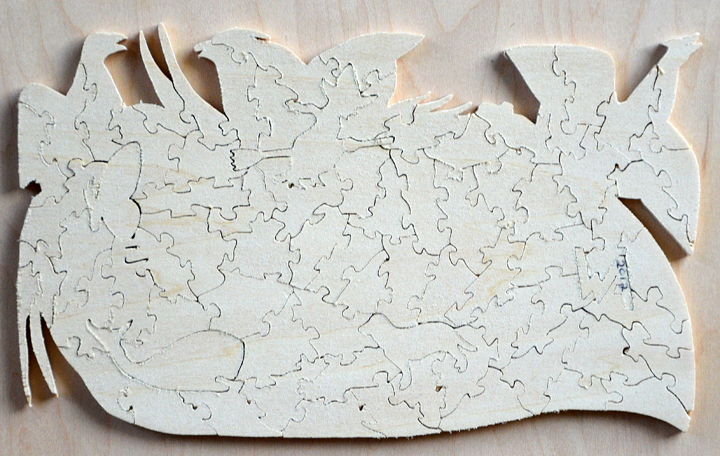
Fox and Pheasants - Back

Figurals and Signature Piece (reverse)
The Golden Retriever (with some gold color of course) celebrate's Pagey Elliott's dog work
The brilliantly placed witch figural along with the whale reflect on Salem MA's background
The Butterfly "the love of the natural world that Anne shares with Pagey"
The Signature Piece (back side showing here) is a monogram of AW (Anne Williams)
with the full year noted

Box
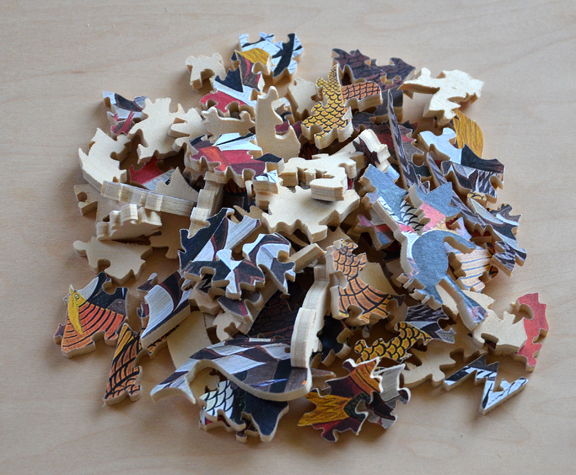
Pile of Pieces
76 Pieces (Box label said "over 70 pieces")
Prominent wooden jigsaw puzzle collector and restorer Bob Armstrong says "Anne Williams is the leading collector, author, historian and lecturer of American jigsaw puzzles with a collection of thousands of puzzles and puzzle related items". And I'll add, she also makes wooden jigsaw puzzles, having cut her first puzzle in 1977. With the puzzles Anne made for the 2012 Puzzle Exchange, Anne included the most comprehensive write-up submitted by any of the puzzle makers. I'm not going to quote it all here (just as I am not quoting other write-ups in full) but will mention some salient points. The print is from an exhibition announcement for a show at the Bates College Museum of art in 1990 which showed a retrospective of Dahlov Ipcar's art, including the painting shown here, "Fox and Pheasants". Anne saved a couple dozen copies of the announcement knowing the image of the painting would make a great puzzle, and she finally got around to using them for this year's Puzzle Exchange.
I enjoyed assembling the puzzle. With no picture, an irregular border and similar colors and patterns showing up in multiple areas, the puzzle took a surprisingly long time to assemble given a piece count of 76 and it not being a "trick" puzzle.
Anne "selected vintage materials" for her Exchange puzzle, using a 3-ply bass wood. She used several brands of blades for the 14 puzzles she made, and used a 65 year old Delta-Rockwell 24" scroll saw. My puzzle was the 11th of the 14 Anne cut. Anne thinks she may have used some puzzle blades she had obtained from Alice Kern who cut puzzle in Portland, Maine in the early 1930's. She (like myself for most of my puzzles) used Elmer's white glue but it "did not hold very well" and had to do some repairs. I found I had to repair a few of these pieces myself. The cutting style is a plain (round) knob, with some flattish Earlet almost bordering a zigzag at times. I noticed a couple of what I call "snatch" marks, this is when cutting a very small section that's usually two or three pieces in size, the saw "snatches" the work from the cutter's fingers, catching it in the blade and quickly moving it up and down until the cutter stops the saw. The "snatch" sequence frequently leaves a little round divot (here one is visible almost at the exact center of the puzzle at the boundary of red and white in the fox). Not much that can be done about these. I freely admit to "making" them from time to time, although much less so in recent years. If not a "snatch" then some else. The bass wood chipped out on the back a bit. Anne elected not to finish the back, or not to the extent some modern cutters do.
Anne's Witch figural is one of the most well placed figurals I have ever seen. The hat, face and neck, a suggestion of shirt and coat and even shoes are all well defined using various parts of a pheasant!
The puzzle came in a box with a well documented label on the top of the lid. I prefer the label to be on the top (as it is here) or on a side of the box (as I normally do with my puzzles in boxes larger than my Exchange Puzzle box), not the bottom. Some exceptions are OK, like Ron Moore's Turtle Teaser box - the label is on the bottom, but there is his very distinctive turtle inlay on the top. At least one exchange puzzle container had no labels anywhere on the outside! When the labels are on the side, puzzles in storage may be identified without removing the boxes from the shelves.
One of the interior blue green tissues has a gold stamp of Anne's signature piece outline, a nice touch.
So there you have it, the ninth of 21 puzzles! Still many more cool puzzles to come!
Review #10 - September 15, 2012
Cutter: Chris Yates
Company: Chris Yates Studios
City: Boulder, CO
Website: www.chrisyates.net

Ignis Absentia - Front (within frame)
Ignis Absentia - Latin for "the absence of fire" per Google Translations
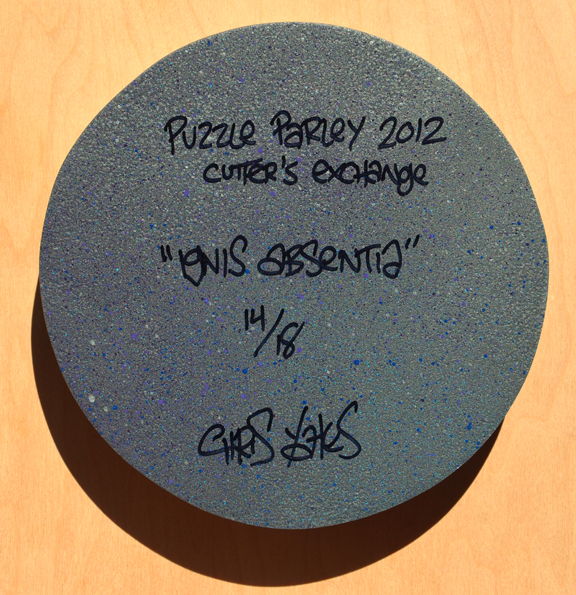
Ignis Absentia - Frame Back
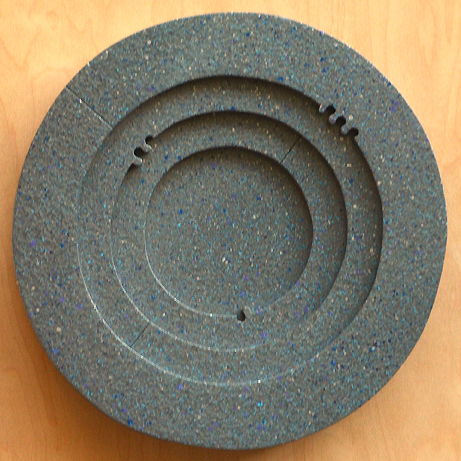
Ignis Absentia - Frame Front without pieces
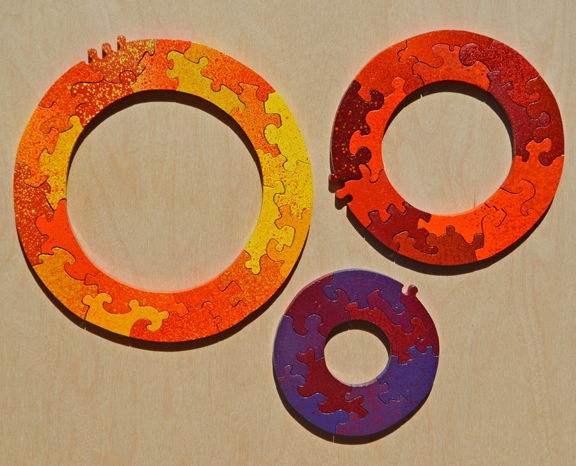
Ignis Absentia - Front (outside frame)

Ignis Absentia - Back (outside frame)
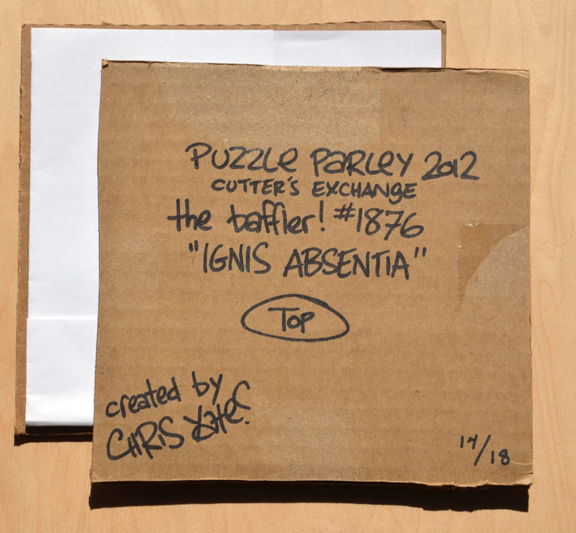
Packaging

Pile of Pieces
44 pieces (9 in bottom ring, 14 in middle ring, 21 in top ring)
Chris Yates of Chris Yates Studios has been making "Bafflers" since 2004 and "as of December 2010 had made and sold over 1300 unique Bafflers". As of September 4th, Chris was working on the design work for his 2000th Baffler!
Chris has an extensive background in the creative arts and I recommend reading about his background (website linked at preface). The direct lineage to Bafflers is his work in designing and making 3-D geographic landscapes he calls "Terraforms" out of MDF (medium density fibre board). In viewing Chris's work on the web, there is a ridiculous amount of creativity, a huge array of multi-level frame structures which provide landscapes for a wide variety of multi-level jigsaw puzzles. Chris has helpers with his expanding enterprise. He has contracted out the production of low cost cardboard emulations of his Bafflers and more recently has launched a digital version for the iPad 2 and iPad 3 / "The New iPad". As I'm still hanging on to my first generation iPad, I haven't been able to try the software out. The software is available at http://itunes.apple.com/us/app/the-baffler%21/id535502977
The Baffler puzzle pieces are spray painted on their sides and fronts but not on their backs The frames are spray painted on all sides. When I asked why the pieces were not sprayed on their backs, the answer is the main issue is with multiple level Bafflers - the "fit" issue rapidly compounds with the levels. Wikipedia mentions some concerns about the Formaldehyde resins used to bind the MDF fibres together, they can be sealed in by painting all sides, although here any toxins are likely extremely low and dissipate over time.
I enjoyed playing with this small puzzle. However, with this small puzzle, the frame gives huge clues about how the pieces fit. I like how the different levels have their own expressions due to the way they are painted, yet the painting is variable enough to cofound the assembler who thinks the layers may be separated by color alone. I later tried assembling the puzzle outside of the frame as separate rings and found this to be more challenging!
One drawback from a collector point of view is that the frames take up a lot of space in proportion to the volume of the pieces, and the frames are relatively heavy. None-the-less the design and execution of some of the larger works I've seen on the web have a "cool" factor that cannot be denied. Amongst his more recent works, I like his "impossible-object" Baffler's, hunt on the web for them!
As for the "box", Chris writes: The original Bafflers (this is what I call all of my puzzles) are sandwiched in their assembled state between two pieces of cardboard and taped, like the one you received. Since each puzzle is a different size, it is impractical to try and make a custom box for each one. Of course, when the puzzle gets shipped out, the sandwich is wrapped in bubble-wrap and put in a sturdy box with packing peanuts, etc.
So there you have it, the 10th of 21 puzzles! Still many more cool puzzles to come!
Review #11 - September 16, 2012
Cutter: Lisa Lee
Company: Forgetmenot Puzzles
City: West Winfield, NY
Website: www.forgetmenotpuzzles.com/

Poppy - Front

Poppy - Back
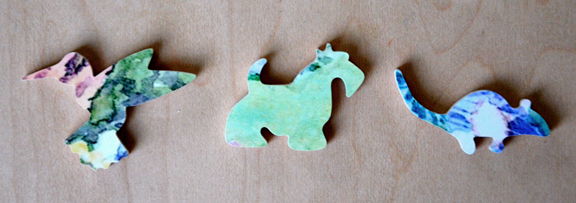
Figurals

Signature piece (back) and and a piece shown edge-on

Container

Pieces
Lisa Lee of Forget Me Not Puzzles is fairly new at cutting puzzles, having cut not quite 75 puzzles, however her experience is vastly supplemented by a lot of experience making replacement pieces. Her replacement piece experience goes back a long way, she started collecting TUCO puzzles (those thick cardboard puzzles with the pink backs) in the 1980's and eventually began making replacement pieces for the missing pieces. At the 2012 Puzzle Parley session on making replacement pieces, she "wowed the crowd" with her home grown replacement piece manufacturing methods and quality! She writes "right now in my house there are about 200 packets of puzzle pieces from various people waiting for my repair skills. I like cutting the pieces more than I like the coloring aspect - I have to say probably within the last year I've gotten SO much better at cutting replacements. So now I really DON'T have time for cutting my own puzzles". In my opinion, those who make replacement pieces add much to the whole human caring-about aspect of puzzles, I'm so glad these experts are around!
As for the puzzle, Poppy, the puzzle is a mixture of easy and hard. The easy part is the border as it has an orange/red trim making it super easy to pick out all the edges ahead of time. The interior is a mixture of extensive color line cutting (clc) and round knobs. The wood is a fairly thin 3-ply, Lisa writes "The wood I use for my puzzles is just a 3 ply Baltic Birch that I get from the local lumberyard, and I am very dissatisfied with it so this week I am scouting out another local source. After looking at everyone's puzzles, I've decided my wood is the worst! .... Yes, it's what I've been using all along". At least the wood did not spawn a bunch of chip-outs on the back. Lisa has experimented with several cutting styles, and when researching her puzzles on her website, I find that for someone who has made "just" 75 puzzles she has come a long way! Also, some of her puzzles are packed with figurals, reminding me a lot of the geometric ones found in U-Nit and some Pastime puzzles, as well as vast variety of animal figurals.
Her signature on this puzzle is on a selected clc'd poppy, I don't think she has her own signature piece shape yet. She, like many of the cutters, uses a DeWalt scroll saw. Her computer prints are spray protected (like mine), not laminated. As for the picture, Lisa writes that she "came across this little image in the spring and thought it would be a great puzzle to cut on the color lines."
The puzzle comes inside an appropriately sized coffee can, the can nicely wrapped with her labels. Remains to be seen how the materials used in the can and lid withstand the ravages of time.
So there you have it, the 11th of 21 puzzles! Still many more cool puzzles to come!


